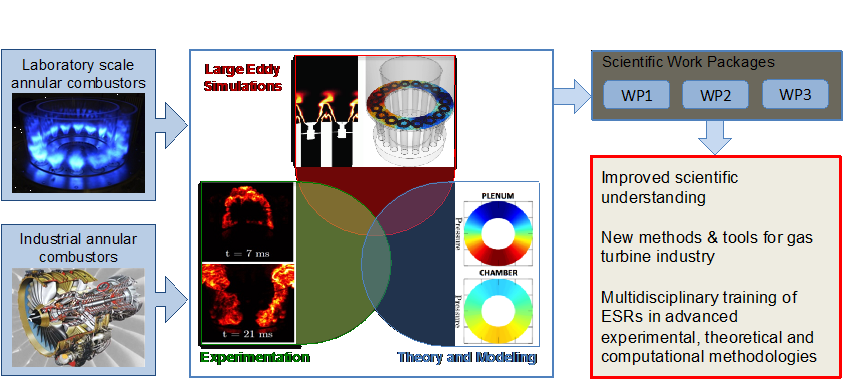Project - ANNULIGhT
Research
The development of next generation low-emission NOx zero-carbon gas turbines is hindered by unsteady combustion problems that are often only discovered late into development because we cannot yet predict them at the design stage. For reasons of cost and simplicity, we have been trying to solve these problems by studying them in isolation in single flames when, in reality, gas turbines have annular or can-annular combustor chambers with multiple flames. These systems are known to have different stability characteristics that need to be understood.
ANNULIGhT has made significant progress in our scientific understanding of these problems by studying them in annular and can-annular combustor geometries. The main challenges addressed are: i) the occurrence of self-excited combustion instabilities in aeroengines and power generation gas turbines which take the form of azimuthal modes in large pressure fluctuations threatening structural integrity, ii) increased probability of lean Blow-off, which consequently makes iii) ignition and light-around more difficult. These latter two issues are safety critical for aeroengine certification yet very little is understood about the mechanisms which control these processes.
The research methodology of ANNULIGhT is shown by the schematic below:

The research work is divided into 3 thematic work packages (WP).
WP1 was focused on improving our understanding of the thermoacoustics of annular combustion chambers. At CNRS/EM2C the thermoacoustic response of annular combustors operating with spray flames showed that self-excited azimuthal instabilities are very sensitive to the spray pattern. In turn, it was found that the spray formation is very sensitive to swirl and other small geometric changes to the injector. These effects were captured by new models and implemented into LES by research at CERFACS.
At NTNU the effect of acoustic boundary conditions and dynamic operation was investigated in atmospheric and pressurized annular combustors. The effect of hydrogen enrichment on the modal dynamics were studied and found to be different in the pressurized rig due to the change in acoustic boundary condition. Dynamic operating conditions, achieved by ramping up in power or equivalence ratio was shown to be able to alter the thermoacoustic response of the system by moving the bifurcation point. ETH Zurich developed a low order model based on quaternions which showed that the non-linear dynamics observed in the experiments at NTNU were caused by symmetry breaking effects.
At TUM mprovements to low-order acoustic network models were achieved by implementing, Bloch element to reduce computational costs, FTF representations in a state space framework and Model Order Reduction techniques for predicting instabilities in annular combustors.
The research focus of WP2 was the passive control and exploitation of symmetry breaking methods to develop reduced order tools to control instabilities. An idealied annular combustor with simulated flames was used at TUB to assess the effect bulk azimuthal swirl and boundary conditions demonstrating that the resulting modes depend on the level of asymmetry.
At NTNU it was shown experimentally that bulk azimuthal swirl suppresses thermoacoustic modes. A new approach to optimize geometries to suppress instabilities were developed at Cambridge by developing adjoint solvers combined with sensitivity analysis. Together ETH and Ansaldo developed new theoretical models based on quaternions for system identification and showed that they can capture the effects of noise and asymmetries which can ultimately be used to optimize damping strategies. A new low order model called STORM was further developed to reduce the time and computational cost of conducting stability analyses in complex industrially relevant configurations.
WP 3 focused on improving our understanding of ignition and extinction dynamics in annular combustion chambers. These processes are crucial to the safe operation of aeroengines. Experimental work was carried out at CNRS, Cambridge and NTNU with complimentary parallel numerical simulations using LES at CNRS, Cambridge and Safran Helicopters.
Experiments on ignition and light around times in premixed flame showed a strong correlation laminar flame speed and to a lesser extent the thermal expansion of the burned gases. In spray flames the opposite was found, thermal expansion was found to be the most important mechanism of flame propagation as it resulted in local modifications to the spray distribution. CNRS also investigated the effect of heated walls on the ignition process and identified the main physics behind the differences in light around times.
Experiments at NTNU showed that azimuthal bulk swirl enhances the ignition and light around process and this process could be well captured by numerical simulations done by SAFRAN.
